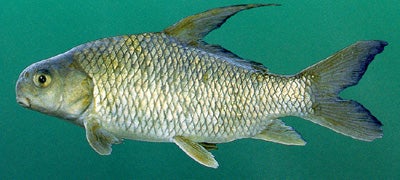SCIENTIFIC NAME: Carpiodes velifer
CHARACTERISTICS: The highfin carpsucker is named for its elongate anterior dorsal fin rays, which when depressed are almost as long as the dorsal fin base. The dorsal fin has 22 to 27 rays; the anal fin has seven or eight rays. The lateral line contains 36 to 38 scales. The snout is blunt and rounded. The upper jaw reaches the front edge of the eye, and a small, nipple-shaped projection appears on the front edge of the lower lip. Highfin carpsuckers have silvery to light bronze bodies and clear fins.
ADULT SIZE: 10 to 16 in (254 to 406 mm)
DISTRIBUTION: Page and Burr (1991) exclude Alabama on their range map for this species. Lee and Platania (1978b) have only one record from the Tennessee River drainage in eastern Tennessee. Boschung (1992) speculates that highfin carpsuckers have not been collected in the Alabama section of the Tennessee drainage since 1936 or 1938. In 1992 and 1993, we collected individuals at only three stations—two in Paint Rock River and one in Cypress Creek. Highfins are widespread and often abundant in the Mobile basin, particularly below the Fall Line and in the tailwaters of most locks and dams. Royal D. Suttkus (1995, personal communication) believes that a new species may be represented by populations found in the Conecuh and Choctawhatchee river drainages in southeastern Alabama and northwestern Florida.
HABITAT AND BIOLOGY: This schooling species occurs primarily in rivers and reservoirs and occasionally in moderate or large streams. Pflieger (1975) reports July spawnings in Missouri. We have encountered tuberculate adults running eggs and milt from April through June, indicating a protracted spawning season in Alabama. We have collected small, 1- to 3- inch highfins along sand and gravel bars in June and July as well as spent but still slightly tuberculate adults as late as August.
ORIGINAL DESCRIPTION: Rafinesque described the highfin carpsucker in 1820.
ETYMOLOGY:
Carpiodes means carplike.
Velifer means sail bearer, referring to this species’ elongate dorsal fin.
The copyrighted information above is from Fishes of Alabama and the Mobile Basin.






